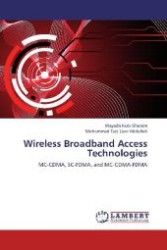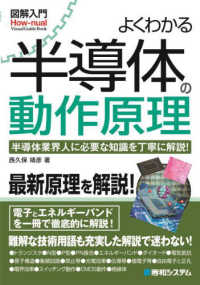Full Description
Foundations of Early Childhood EducationSociety is designed to help increase the quality in early care and education programs through training teachers. It features skill building with a solid theoretical base, and provides students with an overview of early childhood programs through the use of examples, anecdotes, and scenarios. Readers will come away with an understanding of what makes a quality early childhood education program, where children gain the foundations they need for school success and beyond.Instructors and students can now access their course content through the Connect digital learning platform by purchasing either standalone Connect access or a bundle of print and Connect access. McGraw-Hill Connect (R) is a subscription-based learning service accessible online through your personal computer or tablet. Choose this option if your instructor will require Connect to be used in the course. Your subscription to Connect includes the following:* SmartBook (R) - an adaptive digital version of the course textbook that personalizes your reading experience based on how well you are learning the content.* Access to your instructor's homework assignments, quizzes, syllabus, notes, reminders, and other important files for the course.* Progress dashboards that quickly show how you are performing on your assignments and tips for improvement.* The option to purchase (for a small fee) a print version of the book. This binder-ready, loose-leaf version includes free shipping.Complete system requirements to use Connect can be found here: http://www.mheducation.com/highered/platforms/connect/training-support-students.html
Contents
ContentsPREFACE XIXABOUT THE AUTHOR XXVPart 1Foundations of the Teaching-Learning ProcessThe Role of the Early Childhood Educator1 Early TRAINING 6The Value of Reflective Practice 6A Multicultural Perspective 7A Holistic Approach 7Professionalism 9CHILD-DEVELOPMENT HISTORY 18Historical Trends and Figures 18CHILD-DEVELOPMENT THEORISTS AND THEIR THEORIES 21PIONEER READING 362 First Things First: Health and Safety ThroughObservation and Supervision 38OBSERVATION, SUPERVISION AND GUIDANCE 40OBSERVATION SKILLS FOR BEGINNERS 41SUPERVISION SKILLS FOR BEGINNERS 43Focusing on Individuals and the Group 44A Crash Course in Guidance 46Conflict as a Safety Issue 51Risk Taking as a Safety Measure 54Helping Children Learn from Their Experiences 54A SAFE PHYSICAL ENVIRONMENT 55Developmental Appropriateness 55Maintenance as Prevention 56Sanitation Procedures 56Program Policies and Procedures for Health and Safety 57Stress and Frustration as Health and Safety Issues 58A TO KNOW 61FOR FURTHER READING 613 Communicating with Young Children 62COMMUNICATION, RELATIONSHIPS,AND THE COGNITIVE CONNECTION 64LISTENING: AN IMPORTANT SKILL 66Listening and Giving Feedback Are Valuable to Communication CLEARLY 74Ask Real Questions, Not Rhetorical Ones 75Validate Feelings and Perceptions Instead of Discounting Them 75Address Uncomfortable Situations Instead of Ignoring the Obvious 76Be Congruent; Avoid Incongruence 77Watch Out for Double-Bind Messages 78Use Redirection Instead of Distraction 78Be Sensitive About Questioning Children 81USING OBSERVATION AND REFLECTION TO 88The Teacher as Director and Star 89The Teacher as Responder, Protector, and Facilitator 90PLAY, COGNITION, AND LEARNING 90Focus on Inclusion: Making Play Available and Appropriate for All Children 94Playing to Get Smart 97Is Play Always Fun? 97How Does Play Differ from Work? 98Types of Play-Cognitive Toward Work and Their Effect on Children 104Children's Observations of Adults at Work 105The Project Approach to Learning 107THE ADULT'S ROLES IN CHILDREN'S WORK AND PLAY 107The Adult as Observer 107The Adult as Stage 117FOR FURTHER READING 1185 Guiding Young Children's Behavior 120APPROPRIATE 123What's Wrong with Punishment? 124Side Effects of Punishment 127GUIDANCE 130Setting Limits 130Redirection 135Teaching Children to Express Their Feelings 135Modeling Prosocial Behaviors 136Focus on Inclusion: Children with 147FOR FURTHER READING 1476 The Teacher as Model 148MODELING NONVIOLENT PROBLEM SOLVING 151Seeking Information 152Recognizing Alternatives 154Considering Consequences 156The Many Roots of Violence 157MODELING SELF-ESTEEM 159Modeling Virtue 159Modeling Power 160Modeling Significance 162Modeling Competence 164MODELING EQUITY 165MODELING LEARNING, DEVELOPMENT, AND COGNITION 167Reflective Practice and The Importance of Observation READING 1767 Modeling Adult Relationships in Early ChildhoodSettings 178WORKING WITH EACH OTHER: RELATIONSHIPS WITH OTHEREARLY CHILDHOOD EDUCATORS 181Being Sensitive to Cultural Diversity 183Recognizing Some Differences in the Way Adults Approach Problems 183The Importance of Being Authentic 186Handling Adult Disagreements Through Dialoguing 187Teachers Dialoguing: An Example 188WORKING WITH FAMILIES: PROFESSIONALS'RELATIONSHIPS WITH FAMILIES 190Making Families Feel Part of the Program 192Honoring Diversity 193Focus on Inclusion: A Special Kind of Partnership 194Recognizing That Parents' and Providers' Roles Are Different 195Handling Conflicts with Parents 196Facilitating Communication with Families 203Supporting Families 204A Development and Learning 2108 Setting Up the Physical Environment 212SETTING UP ACTIVITY AREAS 216Focus on Inclusion: Modifying the Environment for Special Needs 217Physical-Care Centers 218Infant Play Areas 220Interest Centers 221Gross-Motor Learning Spaces 222OTHER CONSIDERATIONS FOR EARLY CHILDHOOD ENVIRONMENTS 223"Dimensions" 223Space 225How Much Should There Be to Do? 226Circulation Patterns 226Balance 228A SAFE AND HEALTHY ENVIRONMENT 230Ensuring Developmental Appropriateness 230Providing Protection 232Focus on Inclusion: Safe Environments for All 233Assessing the Environment for Safety 234Sanitation and Cleanliness 234THE ENVIRONMENT AS A REFLECTION OF PROGRAMGOALS AND VALUES 236Individuality 237Independence and Interdependence 237Cooperation 237Authenticity 239The Outdoors and Nature 240Exploration Care Center 242Half-Day Parent Co-op 243Half-Day Head Start Preschool 243School-Age Child Care 243Family Child Care Home 245Kindergarten and ENVIRONMENT 250Respect 250WARMTH, NURTURANCE, ACCEPTANCE, PROTECTION, ANDRESPONSIVENESS 253Continuity 255Focus on Inclusion: A Feeling of Belonging ISSUES 258The Child's Home Culture 261The Dynamic Nature of Cultur274Synchronous Interactions 278Attachment 280PHYSICAL-CARE ROUTINES 281Feeding 281Toileting 284Resting 286Grooming and Dressing 288Focus on Inclusion: Adapting Routines for Children with Special Needs 288OTHER READING 29911 Developmental Tasks as the Curriculum: How toSupport Children at Each Stage 300WHAT CHILDREN NEED: A BROAD VIEW 303DEVELOPMENTAL STAGES 306Young Infants 306Mobile Infants 309Toddlers 311Two-Year-Olds 314Three-Year-Olds 316Four-Year-Olds 318Five-Year-Olds 321School-Age Children Assessing 328OBSERVING 334RECORDING 336Anecdotal Records 336Running Record Observations 336Incidents Reports 339Journals 339Photographs, Sound Recordings, and Videos 340Checklists and Mapping 340Time Samples 343ASSESSING 354FOR FURTHER READING 355Part 3Planning for Learning and Development by EnhancingChildren's Curiosity, Joy, and Sense of Wonder 35613 Enhancing Children's Learning and DevelopmentThrough Language and Emergent Literacy 364Facilitating Language Development in Infants and Toddlers 365Facilitating Language Development in Two Year Olds 367Facilitating Language Development in Three, Four, and Five Year Olds 368Facilitating Language Development in School Age Children 374Emergent Literacy 375A Reading-Readiness Approach Versus an Emergent Literacy Approach 378Emergent Literacy for Infants and Toddlers 379Promoting the Development of Emergent Literacy Skills in Three, Four, and Five Year Olds 380Promoting the Development of Emergent Literacy 38714 Fostering Joy in Developmentally AppropriateExperiences in Math and Science 388THE CONSTRUCTIVIST APPROACH 390What Do Children Learn? 391How Do Children Learn? 391MATH 392Infants and Toddlers and Math 392Preschoolers and Math 394School Age Children and Math 395Concepts of Time and Space 395"Real-World Math" 396Games 397SCIENCE 397A Constructivist Approach Versus Formal Science Lessons 397Physics and the Project Approach 398Chemistry and the Project Approach 400Two Basic Science Concepts 401Nature Study 403Transitions Projects 404BASIC EQUIPMENT AND MATERIALS FOR MATH AND Integrating Art, Music, and Social Studies into aHolistic Curriculum 414ART 416What Do Children Gain from Art Experiences? 418Facilitating Art Experiences 421MUSIC 422Facilitating Music Experiences 422Group Time: Singing 423Group Time: Instruments 425Creative Movement 425SOCIAL STUDIES 426Social Studies Begins with Self 426From Self to Others 428From Self and Others to 434FOR FURTHER READING 434ENDNOTES E 436GLOSSARY G-1 445REFERENCES R-1 453PHOTO CREDITS C-1INDEX INER(01): WOW








